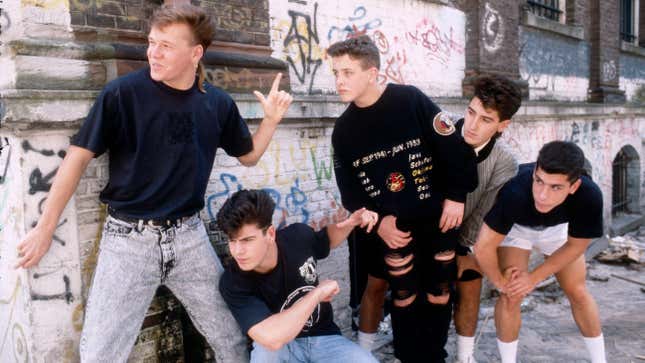

In 1989, New Kids on the Block burst from stardust into the pop music lexicon. Groomed by music-industry impresario Maurice Starr as a white counterpart to the R&B group New Edition, NKOTB were icons to girls worldwide. Though their roots are traced to the hardscrabble Dorchester neighborhood of Boston, ultimately this group of boys—ages 17 to 21 at the time—performed digestible pop music, carving a rare safe space for girls in an era of chauvinist hair metal and increasing hyper-sexualized imagery.
The New Kids’ young voices were pumped through endless radio airplay and music video rotation. Their boyish good looks adorned legions of swag: from posters and t-shirts to dolls, lunch boxes, trading cards, and complete bedding sets. They even had their own Saturday morning cartoon. The original lineup included founding member Donnie Wahlberg’s younger brother Mark, who departed NKOTB for a questionable solo career before breaking out as an actor.
The iconic five-member lineup of Wahlberg, his high school friend Danny Wood, brothers Jordan and Jonathan Knight, and young Joey McIntyre released a self-titled debut in 1986 to little fanfare. Hesitant to call it quits after just one record, Starr allowed the boys more input on their look and sound for their next album. And it made all the difference. Hangin’ Tough was released in September 1988, but it didn’t crack open until ’89, a storm that culminated in the title track peaking at No. 1 on the Billboard Hot 100.
“Hangin’ Tough” became as ubiquitous as Rachel Platten’s “Fight Song” leading up to the 2016 election, and was a similar rallying cry to stand tall and believe in yourself. It had a hook for nearly every type of kid. The ones who felt shy or outcast or bullied at school. The ones who were hyper-competitive. The ones who were into the new Nike “Just Do It” slogan and sports. Its simplistic chorus—a full body chant that set free happy brain chemicals—was easy to remember, and impossible to forget: “Oh, oh, oh, oh, oh/Hangin’ tough,” full stadiums sang, swaying arms like windshield wipers.
-

-

-

-

-

-

-

-

-

-

-

-

-

-

-

-

-

-

-

-

-

-

-

-

-

-

-

-

-

-

-

-

-

-

-

-

-

-

-

-








































